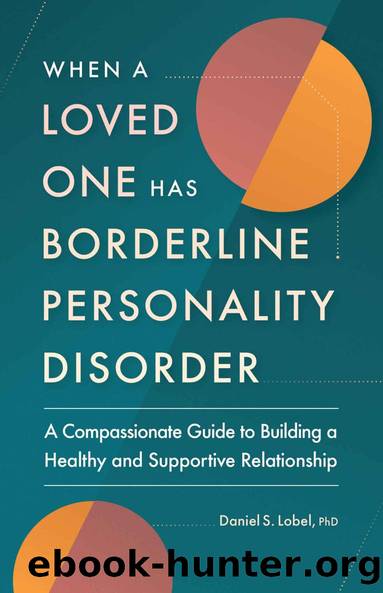When a Loved One Has Borderline Personality Disorder: A Compassionate Guide to Building a Healthy and Supportive Relationship by Daniel S Lobel PhD

Author:Daniel S Lobel PhD [Lobel PhD, Daniel S]
Language: eng
Format: epub
Publisher: Rockridge Press
Published: 2022-05-02T17:00:00+00:00
Setting and Sticking to Boundaries
When your efforts to educate your loved one fail to garner cooperation in enhancing healthy communication, you will have to set and maintain boundaries that do not permit unhealthy communication.
Ideal functioning in intimate relationships occurs when there is maximum cooperation. Setting boundaries becomes an option only after cooperation has been attempted and failed. The hope is that eventually your boundaries are accepted, and your loved one is rewarded by your cooperating with them.
SELECTING BOUNDARIES
Crafting boundaries should be guided by whether behaviors are healthy or unhealthy to you, your loved one, and the relationship. Healthy behaviors should be encouraged and celebrated. Unhealthy behaviors are any behaviors that cause pain or dysfunction in either of you and discourage intimacy in your relationship.
Boundaries must be crafted so that you can effectively set and maintain them. Setting boundaries but not enforcing them makes things much worse.
MAINTAINING BOUNDARIES
There generally is little need to reinforce boundaries with healthy individuals. If you ask them not to smoke in your car, they are appreciative that you told them before they lit up, because they would feel bad if they smoked in your car without realizing that you donât like it.
Individuals with symptoms of BPD and other personality disorders test boundaries. Rather than honoring and respecting boundaries, they are offended by them. They object to them, so they violate them, sometimes overtly and defiantly. For example, when Jennyâs father told her that she is not allowed to take the car out after 10 p.m. because she has a junior license, she grabbed the keys out of his hand at 10:30 and ran toward the garage.
Sometimes testing of boundaries is subtle. For example, Margie told her boyfriend, Sven, that she does not like PDA (public displays of affection). When they met Margieâs parents for dinner at a nice restaurant, she reminded Sven that she did not like to be touched in public. As they were having dinner, he put his hand on her knee under the table. She brushed his hand off. He waited a few minutes and then replaced his hand. She brushed it off and then turned away. He then put his arm around her. She wiggled free and put her coat on. After dinner, she confronted him about his behavior, and he told her that nobody could see under the table, therefore it was not public.
When dealing with individuals who suffer from symptoms of BPD, it is critical that you enforce the boundaries you have set. If you do not, the unhealthy behaviors will increase in frequency and/or intensity. If Jennyâs father does not enforce the 10 oâclock driving limitation, she will assume that she can drive whenever she wants. If Sven is not stopped from touching Margie in public, he will likely expand his range of PDA.
MOTHER KNOWS BEST, BUT GRANDMA WONâT LISTEN
Mandy was a single parent with two children, ages nine and eleven. She had to work full-time to support them, and her mother helped her with the kids after school and on weekends.
Download
This site does not store any files on its server. We only index and link to content provided by other sites. Please contact the content providers to delete copyright contents if any and email us, we'll remove relevant links or contents immediately.
Should I Stay or Should I Go? by Ramani Durvasula(6834)
Why We Sleep: Unlocking the Power of Sleep and Dreams by Matthew Walker(5682)
Fear by Osho(4109)
Flow by Mihaly Csikszentmihalyi(4081)
Why We Sleep by Matthew Walker(3802)
Rising Strong by Brene Brown(3799)
Too Much and Not the Mood by Durga Chew-Bose(3711)
How to Change Your Mind by Michael Pollan(3699)
The Hacking of the American Mind by Robert H. Lustig(3603)
Lost Connections by Johann Hari(3469)
He's Just Not That Into You by Greg Behrendt & Liz Tuccillo(3327)
Evolve Your Brain by Joe Dispenza(3071)
What If This Were Enough? by Heather Havrilesky(2952)
Resisting Happiness by Matthew Kelly(2901)
Crazy Is My Superpower by A.J. Mendez Brooks(2880)
The Courage to Be Disliked by Ichiro Kishimi & Fumitake Koga(2822)
The Book of Human Emotions by Tiffany Watt Smith(2788)
Descartes' Error by Antonio Damasio(2759)
In Cold Blood by Truman Capote(2703)
